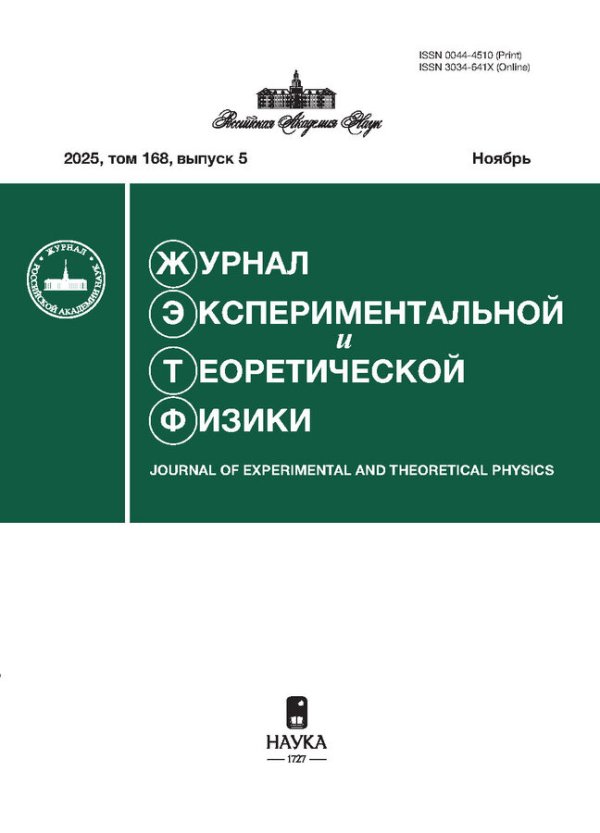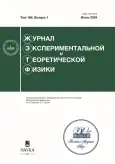Vol 166, No 1 (2024)
 5-8
5-8


MICROWAVE INDUCED RESISTANCE OSCILLATIONS IN TWO DIMENSIONAL ELECTRON SYSTEMS
Abstract
The most important features of microwave induced resistance oscillations in two-dimensional electron systems are considered. The possibility of observing this phenomenon in various material systems using different experimental techniques, including contactless ones, is discussed. Special attention is paid to the influence of electron-electron interaction on the oscillation period, as well as the necessity of depositing metallic layers near the two-dimensional electron system.
Article for the special issue of JETP dedicated to the 130th anniversary of P. L. Kapitsa.
 9-19
9-19


ULTRAFAST EXCITON TRANSPORT IN VAN DER WAALS HETEROSTRUCTURES
Abstract
Excitons in van der Waals heterostructures based on atomically thin transition metal dichalco-genides are considered as potential candidates for the formation of a superfluid state in two-dimensional systems. A number of studies reported observations of ultrafast nondiffusive prop-agation of excitons in van der Waals heterostructures, which was considered by their authors as possible evidence of collective effects in excitonic systems. In this paper, after a brief analysis of exciton propagation regimes in two-dimensional semiconductors, an alternative model of ultra-fast exciton transport is proposed, based on the formation of waveguide modes in van der Waals heterostructures and the radiation transfer by these modes.
Article for the special issue of JETP dedicated to the 130th anniversary of P. L. Kapitsa.
 20-29
20-29


INTERFERENCE OF A CHAIN OF BOSE CONDENSATES IN THE PITAEVSKII–GROSS APPROXIMATION
Abstract
A long chain of Bose condensates freely expands and interferes after being released from an optical lattice. The interference fringes are well resolved both in the case of equal phases of the condensatesand in the case of fluctuating phases. In the second case the positions of the fringes also fluctuate. The spectrum of the spatial density distribution, however, is reproducible despite the fluctuations. Moreover two types of peaks are distinguishable in the spectrum. The first type arises due to the phase fluctuations, the second type is associated with the coherence between the condensates. In the framework of the Pitaevskii–Gross equation we calculate the interference of the condensates and compare the calculation with experiment [Phys. Rev. Lett. 122, 090403 (2019)]. The calculation reproduces the positions of the spectrum peaks, including the dependence on the interparticle interaction. The calculated heights
of the peaks, however, in some cases differ with the experimental ones.
 30-37
30-37


ON THE MICROSCOPIC APPROACH TO THE ANDREEV CURRENT...
Abstract
It was shown how we can describe microscopically the Andreev current in a uniform way for a contact with direct coupling between N and S leads and with intermediate chain of atoms (multilayer system) inside the contact. Considering various types of connection of the normal lead to external thermal bath we reproduce various nonequilibrium distributions at the edge of the normal lead. It was shown what type of connection to the external reservoir corresponds to the classical result of Blonder,Klapwijk and Tinkham. Also we discuss difference in equilibrium and non equilibrium proximity effect, and it is clarified that the Andreev current arises due to the nonequilibrium effects which is much larger than the equilibrium one.
Contribution for the JETP special issue in honor of P. L. Kapitza’s 130th anniversary
 38-44
38-44


GENERALIZED DYNAMICAL KELDYSH MODEL
Abstract
We consider a certain class of exactly solvable models, describing spectral properties an electron moving in random in time external field with different statistical characteristics. This electron can be band – like or belong to a quantum well. The known dynamical Keldysh model is generalized for the case of fields with finite correlation time of fluctuations and for finite transfer frequencies of these fluctuations. In all cases we are able to perform the complete summation of all Feynman diagrams of corresponding perturbation series for the Green’s function. This can be done either by the reduction of this series to some continuous fraction or by the use of the generalized Ward identity from which we can derive recurrence relations for the Green’s function. In the case of a random field with finite transferred frequency there appear the interesting effects of modulation of spectral density and density of states.
Dedicated to 130-th anniversary of Pyotr Leonidovich Kapitza
 45-62
45-62


SPIN HALL EFFECT MEDIATED CONDUCTION ELECTRON SPIN RESONANCE IN METALS
Abstract
The influence of spin-orbit interaction (SOI) on the distribution of spin and charge currents induced in a nonmagnetic conductor by an incident electromagnetic wave is investigated. The effect of SOI on conduction electron spin resonance (CESR) in metals is described. It is established that SOI can significantly alter the CESR line shape. It is shown that this circumstance can be used to determine the SOI magnitude in metal through precision measurements of CESR line asymmetry. The existence of CESR enhancement effect in metals with strong SOI is predicted. It is shown that SOI can lead to enhancement of selective spin transparency and that in a nonmagnetic metal, SOI-induced inversion of electromagnetic wave energy flow can occur – an effect consisting in the emergence of electromagnetic field energy flow directed towards the metal surface in the metal bulk.
Article for a special issue of JETP dedicated to the 130th anniversary of P. L. Kapitsa
 63-73
63-73


PROGRESS, PROBLEMS AND PROSPECTS OF ROOM-TEMPERATURE SUPERCONDUCTIVITY
Abstract
The discovery of superconductivity at megabar (MB) pressures in hydrogen sulfide H3S, followed by metal polyhydrides, starting with binary ones, LaH10 etc., and ending with ternary ones, including (La,Y)H10, has revolutionized the field of condensed matter physics. These discoveries strengthen the hope for solving the century-old problem of creating materials with room-temperature superconductivity. In experiments performed at MB pressures over the past 5 years, besides the synthesis of hydrides, their physical properties were studied using optical, X-ray and Mössbauer spectroscopy methods, as well as galvanomagnetic measurements. We present the main results of galvanomagnetic measurements, including measurements in strong static (up to 21 T) and pulsed (up to 70 T) magnetic fields. Measurements of resistance drop to vanishingly small values at temperatures below the critical Tc value, decrease of critical temperature Tc with increasing magnetic field, as well as diamagnetic screening indicate the superconducting state of polyhydrides. The results of isotope effect measurements, together with the effect of magnetic impurities on Tc, indicate the electron-phonon mechanism of electron pairing. However, interelectron correlations in polyhydrides are by no means small in both superconducting and normal states. Possibly, this is the origin of unusual properties of polyhydrides that have not yet received a satisfactory temperature explanation, such as the linear temperature dependence of the second critical field Hc2(T), linear resistance dependence r(T), as well as linear magnetoresistance, very similar to that discovered by P. L. Kapitsa in 1929.
Article for the special issue of JETP dedicated to the 130th anniversary of P. L. Kapitsa
 74-88
74-88


SUPERCONDUCTIVITY AND INHOMOGENEOUS STATES IN METALLIC HYDROGEN AND ELECTRONIC SYSTEMS WITH ATTRACTION
Abstract
Superconductivity and inhomogeneous states in metallic hydrogen and several electronic systems with attraction, described by inhomogeneous (spatially separated) Fermi–Bose mixture with superconducting clusters or order parameter droplets in a matrix of unpaired normal states, have been considered. The spatially separated Fermi–Bose mixture is realized in bismuth oxide superconductors BaKBiO3. Order parameter droplets can appear in thin films of "dirty" (with high impurity content) metal, described by a two-dimensional Hubbard model of low electron density with strong attraction and strong diagonal disorder. In metallic hydrogen and metal hydrides, droplets and large percolation clusters can form in shock wave experiments near the first-order phase transition boundary between liquid (non-crystalline) metallic and dielectric phases. For homogeneous superconductivity in metallic hydrogen and metal hydrides, within the framework of generalized Eliashberg equations, new results were obtained demonstrating negative sign of derivative dTc / dP < 0, for the pressure range from 60 to 100 hPa in triple hydride LaBH8. From the perspective of unusual physical properties, both in normal and possibly superfluid ("supersolid") states, important analogies between metallic hydrogen and quantum crystals have been highlighted.
Article for the special issue of JETP dedicated to the 130th anniversary of P. L. Kapitsa
 89-97
89-97


JOSEPHSON BIFURCATION READOUT: BEYOND THE MONOCHROMATIC APPROXIMATION
Abstract
 98-109
98-109


TWO-DIMENSIONAL TURBULENCE IN A FINITE BOX
Abstract
We present theory of two-dimensional turbulence excited by an external force in thin fluid films on scales larger than the film thickness. The principal feature of two-dimensional turbulence is the tendency of producing motions of larger and larger scales thanks to the nonlinear interaction. The tendency leads to formation of the so-called inverse cascade and, at some conditions, of big coherent vortices. We discuss the mean velocity profile of the coherent vortices and the flow fluctuations on the background of the mean velocity for different regimes. We demonstrate that the regime of strongly interacting fluctuations leads to an anisotropic scaling inside the coherent vortices.
 110-120
110-120


POWERFUL FLARES AND MAGNETO-ELASTIC OSCILLATIONS OF MAGNETARS
Abstract
Magnetars are neutron stars with superstrong magnetic fields which can exceed 1015 G. Some magnetars (the so-called soft gamma-repeaters – SGRs) demonstrate occasionally very powerful processes of energy release, which result in exceptionally strong flares of electromagnetic radiation. It is believed that these flares are associated with the presence of superstrong magnetic fields. Despite many hypotheses, the mechanism of these flares remains a mystery. In afterglows of the flares, one has often observed quasi-periodic oscillations (QPOs) of magnetar emission. They are interpreted as stellar vibrations, excited by the flares, which are useful for exploring the nature of magnetar activity. The incompleteness of theories employed to interpret magnetar QPOs is discussed.
 121-132
121-132


MAGNETIC FIELDS IN THE NEAR-LUNAR PLASMA: PROPERTIES, MANIFESTATIONS, EFFECTS
Abstract
Possible manifestations of magnetic fields in the near-lunar plasma are considered. It is noted that due to the action of magnetic fields in the Earth's magnetotail, the transport of charged dust particles over large distances above the lunar surface is possible. Accordingly, dusty plasma above the sunlit lunar surface can exist for the entire range of lunar latitudes. Due to significant localization of magnetic anomaly regions, their influence on the transport of charged dust particles over the Moon is insignificant. Nevertheless, it is shown that in magnetic anomaly zones, dusty plasma is "suppressed" compared to the situation outside these zones dusty plasma. Important objects of study are mini-magnetospheres associated with lunar magnetic anomaly zones and responsible for a number of optical and satellite observations, such as "lunar swirls," lower-hybrid turbulence, etc.
Article for the special issue of JETP dedicated to the 130th anniversary of P. L. Kapitsa
 133-148
133-148












